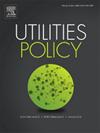Hidden subsidies and behavioral targeting: Insights from Türkiye's three-pillar energy poverty strategy (2019–2023)
IF 4.4
3区 经济学
Q3 ENERGY & FUELS
引用次数: 0
Abstract
This paper examines Türkiye's three-pillar energy-poverty strategy (2019–2023), focusing on the Maximum Settlement Price (AUF), a universal market-wide tariff intervention functionally similar to an inframarginal cap. Using high-frequency EPİAŞ prices and DisCo-level indicators (disconnections, consumption), the analysis shows that AUF acts as an implicit consumer subsidy and, together with the 240-kWh tier, improves affordability for low-consumption users, especially in Eastern and Southeastern regions. Reframing a mechanism often criticized for lowering producer revenues, the study documents its distributional footprint on vulnerable households. By linking market design to energy-poverty outcomes, it offers a cost-effective, replicable template for behavior-informed targeting under crisis conditions.
隐性补贴与行为定向:来自 rkiye三支柱能源贫困战略的启示(2019-2023年)
本文研究了 rkiye的三支柱能源贫困战略(2019-2023),重点关注最高结算价格(AUF),这是一种普遍的市场范围内的关税干预,功能类似于超边际上限。使用高频EPİAŞ价格和迪斯科水平指标(断网、消费),分析表明,AUF作为一种隐性消费者补贴,与240千瓦时的电价层一起,提高了低消费用户的负担能力。特别是在东部和东南部地区。该研究重新构建了一种经常因降低生产者收入而受到批评的机制,记录了其对弱势家庭的分配足迹。通过将市场设计与能源贫困结果联系起来,它为危机条件下的行为知情定向提供了一个具有成本效益、可复制的模板。
本文章由计算机程序翻译,如有差异,请以英文原文为准。
求助全文
约1分钟内获得全文
求助全文
来源期刊

Utilities Policy
ENERGY & FUELS-ENVIRONMENTAL SCIENCES
CiteScore
6.80
自引率
10.00%
发文量
94
审稿时长
66 days
期刊介绍:
Utilities Policy is deliberately international, interdisciplinary, and intersectoral. Articles address utility trends and issues in both developed and developing economies. Authors and reviewers come from various disciplines, including economics, political science, sociology, law, finance, accounting, management, and engineering. Areas of focus include the utility and network industries providing essential electricity, natural gas, water and wastewater, solid waste, communications, broadband, postal, and public transportation services.
Utilities Policy invites submissions that apply various quantitative and qualitative methods. Contributions are welcome from both established and emerging scholars as well as accomplished practitioners. Interdisciplinary, comparative, and applied works are encouraged. Submissions to the journal should have a clear focus on governance, performance, and/or analysis of public utilities with an aim toward informing the policymaking process and providing recommendations as appropriate. Relevant topics and issues include but are not limited to industry structures and ownership, market design and dynamics, economic development, resource planning, system modeling, accounting and finance, infrastructure investment, supply and demand efficiency, strategic management and productivity, network operations and integration, supply chains, adaptation and flexibility, service-quality standards, benchmarking and metrics, benefit-cost analysis, behavior and incentives, pricing and demand response, economic and environmental regulation, regulatory performance and impact, restructuring and deregulation, and policy institutions.
 求助内容:
求助内容: 应助结果提醒方式:
应助结果提醒方式:


